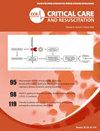Temperature profiles in adult intensive care unit patients treated for infection in a tertiary intensive care unit: A single-centre prospective observational cohort study
IF 1.7
4区 医学
Q3 CRITICAL CARE MEDICINE
引用次数: 0
Abstract
Objective
The objective of this study was to evaluate temperature profiles in patients treated for infections in the intensive care unit (ICU) to establish the number of patients who might be eligible for a clinical trial of therapeutic warming.
Design, setting, and participants
A prospective observational study was conducted in a Wellington ICU over a 3-month period in 2024 including consecutive adult unplanned admissions and excluding those with brain injury or seizures.
Main outcome measures
We screened 200 eligible patients. Our primary outcome was the proportion of all unplanned ICU admission episodes where patients were treated for infection within 14 days in the ICU. Patients treated for an infection were divided into four groups (≥38.3 °C, ≥37.5–38.2 °C, 36–37.4 °C, and <36 °C) using their most recent temperature prior to the first antimicrobial in the ICU (or at admission for patients already on antimicrobials). A key physiological/process measure was the fever deficit, defined as the number of degree-hours <38.3 °C within 24, 48, and 72 h.
Results
A total of 43.3% of unplanned ICU admissions resulted in treatment of infection within 14 days. A total of nine of 123 patients had a body temperature ≥38.3 °C (7.3%) when first treated for infection in the ICU, while 94 of 123 patients (76.4%) had a body temperature <37.5 °C. Fever deficits over 24-, 48-, and 72-h periods increased by decreasing body temperature group with a high proportion of hours spent with a body temperature <38.3 °C in all groups.
Conclusion
A large number of patients treated for infection in the ICU may be able to be included in a trial evaluating induced hyperthermia.
在三级重症监护病房接受感染治疗的成人重症监护病房患者的体温分布:一项单中心前瞻性观察队列研究
目的本研究的目的是评估重症监护病房(ICU)感染患者的体温分布,以确定有资格进行治疗性升温临床试验的患者数量。设计、环境和参与者:一项前瞻性观察性研究于2024年在惠灵顿ICU进行,为期3个月,包括连续的成人意外入院,排除脑损伤或癫痫发作患者。我们筛选了200名符合条件的患者。我们的主要结局是所有非计划的ICU入院事件的比例,其中患者在ICU 14天内接受了感染治疗。根据患者在ICU首次使用抗菌药物前(或已使用抗菌药物的患者入院时)的最新体温,将接受感染治疗的患者分为四组(≥38.3°C、≥37.5-38.2°C、36 - 37.4°C和36°C)。一个关键的生理/过程测量是发热不足,定义为24、48和72 h内38.3°C的度小时数。结果共有43.3%的非计划ICU入院患者在14天内导致感染治疗。123例患者首次在ICU接受感染治疗时体温≥38.3°C的有9例(7.3%),体温≥37.5°C的有94例(76.4%)。在24、48和72小时内,体温降低组的发热不足增加,所有组体温保持在38.3°C的时间比例都很高。结论大量在ICU接受感染治疗的患者可以纳入诱导热疗的评估试验。
本文章由计算机程序翻译,如有差异,请以英文原文为准。
求助全文
约1分钟内获得全文
求助全文
来源期刊

Critical Care and Resuscitation
CRITICAL CARE MEDICINE-
CiteScore
7.70
自引率
3.40%
发文量
44
审稿时长
>12 weeks
期刊介绍:
ritical Care and Resuscitation (CC&R) is the official scientific journal of the College of Intensive Care Medicine (CICM). The Journal is a quarterly publication (ISSN 1441-2772) with original articles of scientific and clinical interest in the specialities of Critical Care, Intensive Care, Anaesthesia, Emergency Medicine and related disciplines.
The Journal is received by all Fellows and trainees, along with an increasing number of subscribers from around the world.
The CC&R Journal currently has an impact factor of 3.3, placing it in 8th position in world critical care journals and in first position in the world outside the USA and Europe.
 求助内容:
求助内容: 应助结果提醒方式:
应助结果提醒方式:


